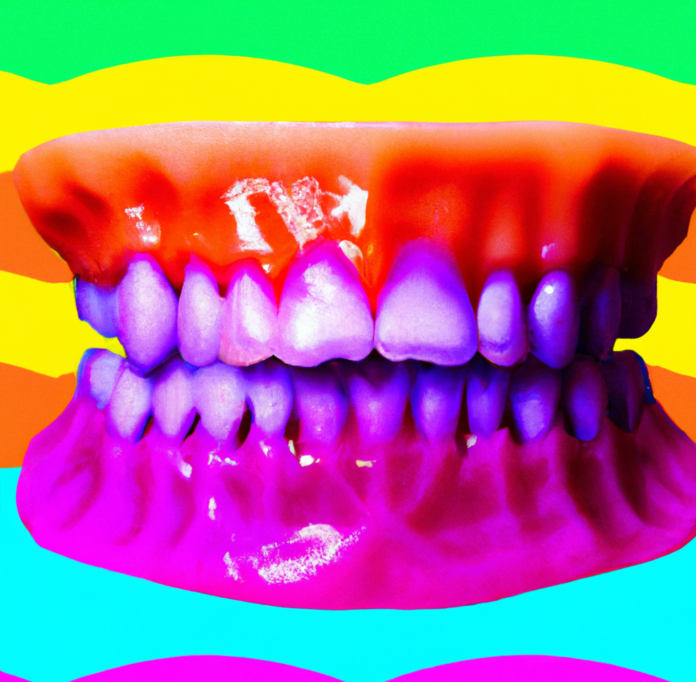Written by F. Sameeha. A. Hamid
Inarguably, it is clear that poor oral care is a one-way ticket to poor oral health. Although the diseases are vast, in this article, we will delve into the ripple effect of poor oral hygiene, focusing on three significant disorders: gum disease, oral cancer, and an unexpected link to neurodegenerative disorders.
Gum disease
Brush before they bleed
Gum disease or in fancier terms, ’gingivitis’ is the inflammation of the gums and is characterized by red, swollen, bleeding gums. Although it may seem harmless initially, it can progress to periodontitis, causing damage to the tooth-supporting tissues.
Gingivitis is caused by the accumulation of plaque, a thin film of bacteria, including Streptococcus mutans, lurking in the nooks and crannies of the mouth. When someone does a bad job of cleaning their teeth (or does no cleaning at all), these bacteria feed and ferment on the leftover sugars and produce acids and other waste products that cause swelling and inflamed gums.
Smokers, diabetics and women with hormonal changes during pregnancy are more likely to develop gingivitis. Additionally, the use of immunosuppressant drugs and medicines that treat cardiovascular problems can encourage the swelling of gums making them difficult to clean, thereby promoting the onset of gingivitis. For instance, following the administration of Cyclosporin which is the most common immunosuppressive drug, gingival overgrowth was observed in more than half of patients after a renal transplant in a study.
If left unattended, periodontitis proceeds. Here, as the gums enlarge, they bulge out and form dents or gum pockets (a cute name to describe a painful experience). These pockets might deepen, inviting further deposition of bacterial plaque around the tooth’s neck. Not even the bristles of your toothbrush can now properly remove the plaque. With the deepening of the gum pockets, wobbling of the tooth may ensue and with the hardening of the bacterial plaque, the protective parts of the cavity could get exposed and subjected to further inflammation.
It’s important to keep healthy gums beneath a pretty smile. Visiting the dentist should never be a burden, albeit an opportunity to learn more about any specific oral regimen you could adopt to avoid any more compromisations.
Oral Cancer
Rising as we speak
Just because one class of cancer is spoken about less frequently, it doesn’t mean it isn’t equally deadly. Oral cancer, often overshadowed by other forms of cancer, presents a grim reality with a mere 5% survival rate for the first five years. This cancer, termed “oral squamous cell carcinoma,” originates from squamous cells found in the linings of body cavities and hollow organs. The tongue, mouth floor, and lower lip are common sites for oral cancer development, with men being at a higher risk compared to women.
Smoking, alcohol consumption and a lesser-known culprit: betel leaves consumption are major risk factors towards the likeliness of oral cancer.
The sad thing is that the inhalation of cigarette smoke by second-hand smokers up their risk of oral cancer by a whopping 87% compared to people who are not surrounded by environments heavy with cigarette smoke. The smoke has a negative impact on one’s immunity by promoting the onset of gingivitis, periodontitis and oral cancer. Tobacco also contains several carcinogens (cancer causing substances). These undergo chemical changes by oxidative enzymes, and metabolism that releases reactive oxygen species that ultimately promote mutations.
Alcohol has the ability to dissolve the lipid components of the oral cavity’s epithelium. This increases its exposure as well as permeability, inviting all sorts of unprecedented substances. Thus, DNA synthesis and repair is hindered and degeneration of the cavity follows. Betel leaf chewing, prevalent in Asia for its energizing effects, has a downside. The betel nut, containing alkaloids like arecoline, acts as the fourth psychoactive drug after nicotine, alcohol, and caffeine. Arecoline reproduces the harmful effects of a typical carcinogen.
Neurodegerative disorders
Unexpected Links
The last connection many would have thought of (me including) is the one between the mouth and the brain. Sure a literal connection makes sense. Don’t we all think before we speak? At the very least most of us? Uncannily, there does exist a relation between the oral cavity and the nervous system. As discussed earlier, Porphyromonas gingivalis is a keystone pathogen of periodontitis, one of the many ripple effects of poor oral care. Constituting bacterial plaque, this gram negative bacteria poses a risk factor towards Alzheimer’s disease. Now I’m pretty sure you must be thinking of the sudden 360 change: How did we go from gum disease to alzheimers?
Episodes of inflammation following periodontitis allows the infiltration of keystone pathogen P. gingivalis and its virulence factors like lipopolysaccharides (LPS) into the periodontal pockets. This leads to the localized tissue destruction and inflammation. Addition to LPS, gingipains are a type of proteinases produced by P.gingivalis. Gingipains destroy the epithelial transmembrane proteins affecting the tight junction proteins between capillary endothelial cells. Once the tight junction integrity is perturbed, the permeability of the blood brain increases inviting all sorts of harmful metabolites. Following the induction of active gingipains in an in-vitro culture system, a loss of 25% neurons were observed. This draws a connection between consequences of periodontitis and neurodegenerative disorders like Alzheimers.
In conclusion…
Although the aforementioned might seem a little intimidating, the take home message really is to take care of your oral health and hygiene because the ripple effect of poor oral care is not a joke! A disturbance in your oral health has an unhappy impact in your daily life and the conversations you hold. Speaking of conversations, before you book your next dentist appointment don’t go unaware. Have an idea on what you’d like to communicate with your dentist regarding any dental problems. They’re here to help, not just hack at your teeth in the clinic. In conclusion, the message is clear: prioritize your oral health and hygiene. Neglecting oral care can have profound implications on your daily life and the quality of conversations you hold.
References
Kanagasingam, S., Chukkapalli, S. S.,Welbury, R., & Singhrao, S. K. (2020). Porphyromonas gingivalis is a Strong Risk Factor for Alzheimer’s Disease. Journal of Alzheimer’s disease reports, 4(1), 501–511. https://doi.org/10.3233/ADR-200250
InformedHealth.org [Internet]. Cologne, Germany: Institute for Quality and Efficiency in Health Care (IQWiG); 2006 Gingivitis and periodontitis: Overview.https://www.ncbi.nlm.nih.gov/books/NBK279593/
Tungare S, Paranjpe AG. (2022) Drug Induced Gingival Overgrowth.[Online] StatPearls Publishing; Available from: https://www.ncbi.nlm.nih.gov/books/NBK538518/
Rivera C. (2015). Essentials of oral cancer. International journal of clinical and experimental pathology, 8(9), 11884–11894. https://www.researchgate.net/publication/283455295_Essentials_Of_Oral_Cancer


